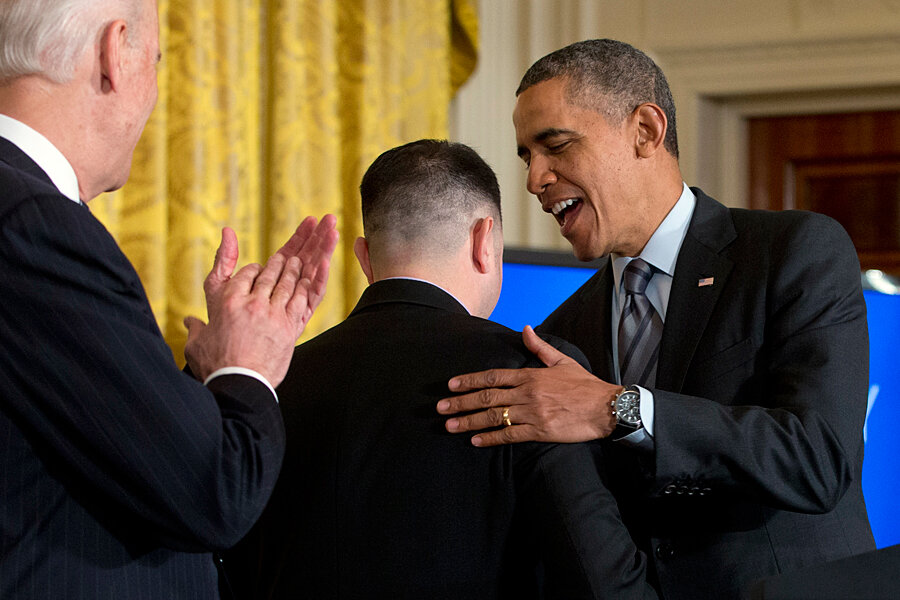CEOs vow to hire more long-term unemployed. Why that helps the economy.
Loading...
| Washington
Some 300 businesses, including many of the nation’s largest, have pledged to follow new hiring practices designed to ensure that job applicants who have been unemployed for a long time don’t routinely fall to the bottom of the pile.
While it won’t resolve the problem of long-term unemployment overnight, it’s a step that could help with what a new White House report calls “perhaps the worst legacy of the financial crisis and ensuing recession.”
The corporations pledging the new hiring policies represent some of America’s best-known business entities: Disney, McDonald’s, GM, Ford, Apple, AT&T, Procter & Gamble, and more.
President Obama put the companies and their “best practices” pledge in the spotlight at a White House meeting Friday. He also signed an executive order committing the federal government to follow those same practices – to prevent screening out applicants based essentially on their unemployment status.
For nearly 4 million Americans who have been out of work and on the hunt for more than 26 weeks, this is welcome news.
And the move may be important for the broader economy in ways that could be felt for years to come.
That’s because a worker who is jobless for months or years may end up dropping out of the labor force entirely, or seeing skills and earning potential erode. The result is a nation with permanently weaker “human capital,” a key building block of economic growth.
“Giving up on the unemployed will create a drag on our economy that we cannot tolerate,” Mr. Obama said, channeling the views of economists. “We are stronger ... when America fields a full team.”
Of course, a key to getting people back to work is jobs, not just pledges about how human resource departments will review applications. And jobs are needed by all types of unemployed Americans, not just those who have already passed the 26-week mark that brings the Labor Department’s “long-term” label with it.
Obama and his administration are touting a range of proposals designed to rev up job creation: immigration reform, proposed free-trade deals, infrastructure spending, reform of corporate taxes, and improving programs that aim to retrain workers.
Republicans in Congress have their own agenda, which overlaps somewhat but includes a different approach to things like taxes and the energy industry.
Bringing jobs back means, in part, creating whole new industries and nurturing more entrepreneurship. That’s because, in contrast to recessions of yore, many of the jobs lost in the latest downturn appear to be gone for good.
But many economists agree that, even as overall job creation is the top priority, some special focus on helping those who have been jobless the longest is warranted.
For one thing, as the White House points out in its new report, the share of the work force unemployed for 26 weeks or less is essentially back to pre-recession levels.
“The entire elevation in the unemployment rate is now due to the long-term unemployed,” Jason Furman, chairman of the White House Council of Economic Advisors, said at a breakfast for reporters hosted by The Christian Science Monitor Friday.
The report found that today, nearly five years after the recession’s official end, some 2.5 percent of the work force is “long term unemployed” people. That’s near the highest rate seen in post-1948 records prior to the recession, although it’s down from its 2010 peak above 4 percent.
Nor are the long-term unemployed all old factory workers or middle-aged construction workers. Many are women. And many are relatively young – people for whom a long bout with joblessness can dent earning prospects for decades to come.
Obama sketched the potential challenge for workers of any age. It affects people’s physical and mental health, he said, “and over time, you can have a negative feedback where it becomes harder and harder for folks to get back in the game because they're just getting so many discouraging messages.”
The challenge is also on the radar of the Federal Reserve, where incoming Chair Janet Yellen has said she’ll do all she can to promote full employment, partly because of the long-term risks for the nation’s work force.
“These are not just statistics to me,” she said in a 2013 speech. “We know that long-term unemployment is devastating to workers and their families.”
She said the problem “is also a great concern because it has the potential to itself become a headwind restraining the economy” in the future.
The good news is that the economy appears to be growing at a solid enough pace to keep the unemployment rate on a downward path for long- and short-timers alike.
But some portion of the potential work force may be so discouraged that it will be hard to draw them back in – and up to their productive potential – when jobs start appearing more abundantly.
The rate of adult participation in the labor force has been falling. Part of the decline since the recession is due to a rising number of baby boomers reaching retirement age. But that demographic trend still leaves some share of working-age people in a dropout category.






